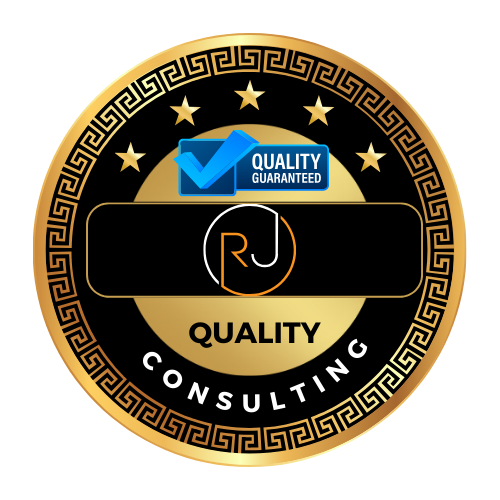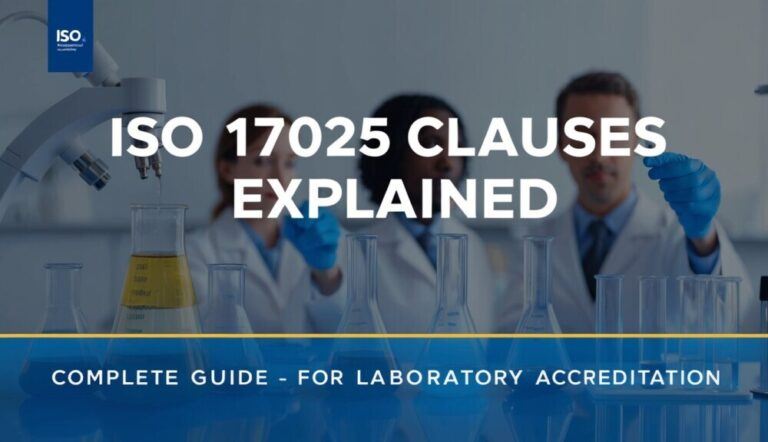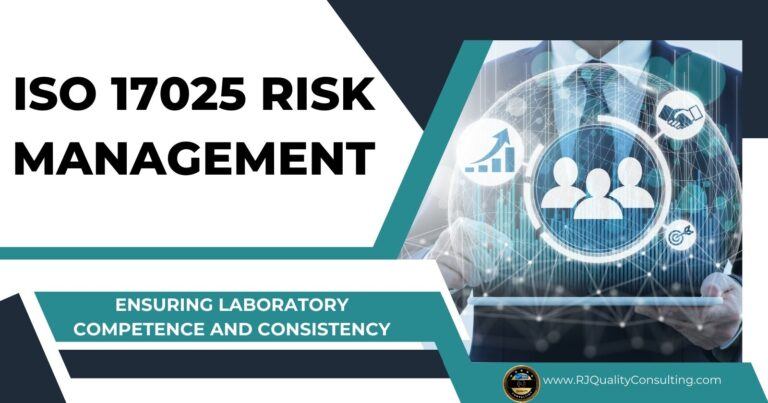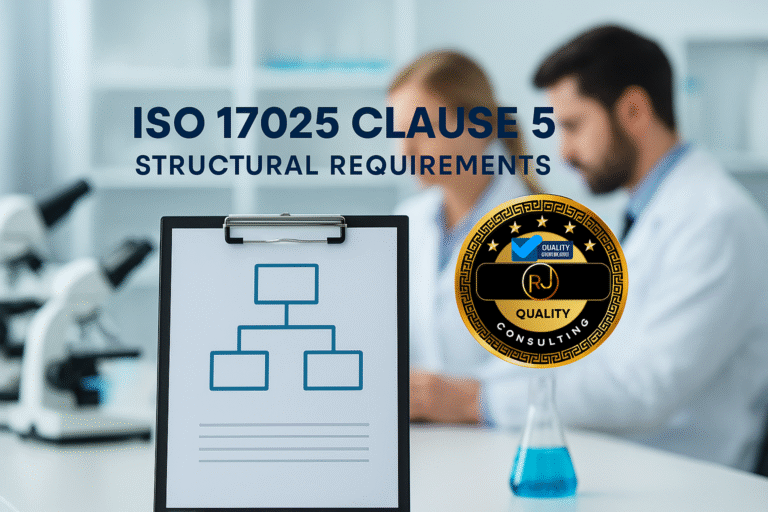Measurement Traceability in ISO 17025 – Essential Requirements and Best Practices
Measurement traceability is a key requirement of ISO 17025 and ensures that your lab’s results can be linked to recognized standards with proven accuracy. This means your measurements must connect through an unbroken chain of comparisons to national or international measurement standards. Traceability is important because it builds trust in your lab’s work, showing that your data is reliable and valid.

If you want your lab to meet ISO 17025 standards, you need to understand exactly how traceability works and why it matters. This includes using proper calibration methods, keeping detailed records, and working with certified reference materials. Accurate traceability processes help you solve problems quickly, pass audits, and support your customers with confidence.
📘 ISO/IEC 17025 Quality Manual Template
Accelerate your lab’s accreditation process with our comprehensive Quality Manual Template, designed to align with ISO/IEC 17025:2017 standards.
- Fully editable and customizable to fit your laboratory’s needs.
- Includes all necessary procedures, forms, and policies.
- Structured to facilitate easy implementation and compliance.
- Developed by experts with extensive ISO/IEC 17025 experience.
Key Takeaways
- Traceability connects your measurements to national or international standards.
- Accurate records and calibration are essential for meeting ISO 17025 requirements.
- Reliable traceability helps your lab build trust and prove its results.
🎥 Watch: ISO 17025 Measurement Traceability Explained
Understanding measurement traceability is crucial for laboratories aiming for ISO/IEC 17025 accreditation. In the video below, I delve into the concept of traceability, its significance in laboratory settings, and how to effectively demonstrate it during audits. This visual guide complements the insights shared in this article, offering a comprehensive overview to enhance your lab’s compliance efforts.
Understanding Measurement Traceability
Measurement traceability lets you prove your results are reliable, consistent, and based on recognized standards. In ISO 17025, this protects the accuracy and validity of your measurements with clear, documented proof.
Definition and Principles
Measurement traceability means your measurement results can be linked by an unbroken chain of calibrations or comparisons to a reference standard, usually national or international standards. Each link in this chain must show its own uncertainty and must use documented procedures.
You need to document every step, making sure there is clear evidence of each comparison or calibration. The uncertainty for every step must be known and controlled. Traceability helps your lab show that its results are based on accepted references, not guesses or assumptions.
A traceability chain can be shown like this:
| Step | Element |
|---|---|
| 1 | International Standard |
| 2 | National Standard |
| 3 | Reference Laboratory |
| 4 | Your Laboratory Instrument |
| 5 | Measurement Result |
Importance in Laboratory Settings
In your laboratory, traceability is not optional. ISO 17025 requires that tests and calibrations deliver results you can trust. If your measurement results are not traceable, you cannot prove their validity, and customers or regulators may not accept them.
Traceability reduces errors by holding every process to a global reference. This keeps your results consistent, whether over time or between different locations. Documenting the full traceability chain helps meet audits and quality checks with clear evidence.
Without traceability, results from different labs might not match. This can lead to confusion, rework, or even safety risks if decisions are based on unproven data.
Metrological Traceability Explained
Metrological traceability is the technical term for measurement traceability. It is a property of a measurement result, showing that it relates to a reference through a documented chain of calibrations. Each comparison in the chain must be performed by a competent lab, often one accredited to ISO/IEC 17025.
You must use reference standards or calibrators that have calibration certificates showing traceability to higher-level standards. The ISO/IEC 17025 standard requires labs to keep clear records of all calibrations, standards used, and measurement uncertainties at every step.
If any step in this chain is broken or not documented, the traceability—and validity—of your measurement result is lost. Traceability gives your measurement results worldwide recognition and trust.
Measurement Traceability Requirements in ISO/IEC 17025

ISO/IEC 17025 sets specific standards to ensure measurement traceability is established and maintained in testing and calibration laboratories. You must meet key requirements that focus on technical accuracy and laboratory competence to achieve and keep your accreditation.
Key Clauses Addressing Traceability
Measurement traceability is mainly covered in ISO/IEC 17025:2017 under clauses related to equipment and calibration. You must ensure all measurement results can be traced to national or international standards through unbroken chains of calibrations, each with stated uncertainties.
A summary of related clauses:
| Clause | Focus Area |
|---|---|
| 6.4 Equipment | Control and calibration of equipment |
| 6.5 Metrological Traceability | Ensuring unbroken chains to reference standards |
| 7.6 Evaluation of Measurement Uncertainty | Assessing and reporting uncertainties |
Laboratories must keep records of calibrations and use reference standards that are either certified or traceable to recognized bodies, such as national metrology institutes. If no such standards exist, you need to document your approach to demonstrate suitable measurement traceability.
Competence and Technical Requirements
Competence under ISO/IEC 17025:2017 means your laboratory staff must be trained and skilled in traceability practices. You need to use proper procedures for calibration, measurement, and data recording according to your laboratory’s scope of accreditation.
To fulfill technical requirements, you should:
- Use ISO/IEC 17025-accredited calibration services when possible.
- Regularly review and verify competence through proficiency testing.
- Maintain a detailed documentation system for all calibration activities and measurement results.
Conformity assessment bodies expect that your staff can explain the traceability chain and show how each measurement meets the required standards. This level of competence supports confidence in your laboratory accreditation and helps demonstrate compliance during assessments.
Establishing Traceability to National and International Standards

To meet ISO 17025 requirements, you must link your measurement results to accepted standards. This keeps your laboratory’s results reliable and comparable to others around the world.
Role of National Metrology Institutes
National Metrology Institutes (NMIs) set and maintain primary national standards. Examples are NIST in the United States and NPL in the United Kingdom. When your lab calibrates instruments, it often starts with reference standards from these institutes.
Each step in calibration should connect back to the NMI’s primary standard. This creates an unbroken chain called metrological traceability. Using certified reference materials and documented procedures, you ensure that your measurements remain valid and trusted.
National standards help your laboratory prove that test results are accurate and trustworthy. It is important to keep records of each calibration and reference used, as ISO 17025 requires clear proof of traceability.
Using International Standards
International standards, such as those from ISO or IEC, give a global framework for measurement and testing. They ensure consistency even when national standards differ. By referencing international standards, your lab can align its calibration and testing processes with best practices recognized worldwide.
In some cases, there may not be a national standard for a specific measurement. Then, you might reference international or regional standards, or use certified reference materials recognized globally. This keeps your traceability aligned with ISO 17025’s requirements, even when working across borders.
Key steps to follow:
- Use reference materials certified to international standards
- Adopt approved international test methods
- Record the chain of traceability when working with foreign reference standards
This approach makes your results reliable and accepted beyond your own country.
Calibration and Reference Materials

Accurate measurements in your laboratory depend on reliable calibrations and trusted reference materials. Following ISO 17025 helps you keep all calibrations documented and reference materials validated for each test and measurement.
Calibrations and Their Documentation
Calibration links your equipment to international standards through an unbroken chain. You must have each instrument calibrated by a lab that uses traceable methods, often accredited under ISO/IEC 17025. Make sure you get a calibration certificate with each calibration. This certificate should clearly show the results, the uncertainty, and the methods used.
Keep records of every calibration. Your documentation needs to include the date, the equipment used, certificate numbers, and who did the calibration. Regular reviews of calibration data help you find trends and prevent mistakes.
Here is a checklist to use when reviewing calibration certificates:
- The reference standards used
- Measurement results with uncertainties
- Calibration method
- Date and identification of equipment
- Name and accreditation of calibration provider
Ensuring Valid Reference Materials
Reference materials play a key role in calibration and testing. You should use materials that have been validated and come with certificates from reliable providers. These providers should be accredited, often to ISO 17025 or a similar standard.
Check all certificates for details like traceability, assigned values, and the uncertainty linked to those values. If you prepare in-house reference materials, validate them with a clear process and document each step. Regular performance checks and comparisons with certified materials help you keep accuracy.
Store and use reference materials according to provider instructions. Keep certificates up to date and ensure all staff understand how to handle and document the use of these materials.
Measurement Uncertainty and Validation
Measurement uncertainty tells you how reliable your test results are. Validation checks that your methods produce results you can trust in your daily lab work.
Uncertainty Calculation and Expression
ISO 17025 Measurement uncertainty is a numerical value that shows how much doubt there is in a measurement. You need to identify all possible sources of error, such as equipment, calibration, the environment, and how samples are handled. This is directly tied in with ISO/IEC 17025 section 6.5.1 where it states:
“The laboratory shall establish and maintain metrological traceability of its measurement results
by means of a documented unbroken chain of calibrations, each contributing to the measurement
uncertainty, linking them to an appropriate reference”.
I created a video below that discusses uncertainty of measurement that I think you will find interesting and helpful:
To calculate uncertainty, first list all contributing factors. Group them as either type A (evaluated by statistical analysis, like repeated measurements) or type B (evaluated using other data, like manufacturer’s specs). Combine these factors using mathematical formulas, usually by taking the square root of the sum of the squares (root-sum-square method).
You must express uncertainty clearly in your reports. The result includes the measured value plus or minus the uncertainty, like 10.0 mg/L ± 0.2 mg/L. This format helps others understand how accurate and reliable your measurements are.
Method Validation Processes
Validation means testing your measurement method to make sure it works as intended. In ISO 17025, you need to show your method gives accurate, repeatable, and reliable results for the intended purpose.
During validation, you should check aspects like accuracy, precision, specificity, linearity, range, and robustness. You can use reference materials or compare your results with another trusted method. Keep detailed records of all tests, results, and any problems you find.
After successful validation, you should keep reviewing the method using quality control checks. This ensures your measurement results remain valid and trustworthy in routine use.
Sampling and Traceability in Practice
Sampling plays a critical role in ensuring traceability in ISO 17025 laboratories. How you choose, collect, and process samples directly affects the reliability of your measurement results.
Sampling Strategies and Their Impact
You need clear strategies for sampling to get trustworthy measurements. Sampling plans should detail how, when, and where samples are collected. Each step, from selecting locations to labeling, impacts the accuracy of your results.
Proper documentation is key. You must record information like sample origin, time of collection, and conditions. This creates a chain of traceability back to the original source.
If your sampling method is not consistent or well-defined, measurement results may not be comparable or reliable. Errors in this process can cause issues with metrological traceability, making it difficult to verify results against reference standards.
Following ISO 17025, your records should allow someone else to trace every tested item back to its source. Using clear procedures minimizes errors and supports compliance.
Internal Audits and Continuous Improvement
Internal audits help you check that your lab’s measurement traceability meets ISO 17025 standards. These audits also find problems and create chances for you to improve your processes, records, and results.
Traceability Checks During Audits
When you carry out an internal audit, you must verify that all measurement results are traceable to recognized standards. You do this by checking calibration records, certificates, and links to national or international standards.
Use clear documentation to show how traceability is established for each measurement. Each audit should confirm that the documentation matches the ISO 17025 and ISO 9001 requirements.
Checklists are useful to make sure you review each step of the traceability chain. For example:
| Audit Step | What to Check |
|---|---|
| Equipment | Calibration status, certificates |
| Records | Traceability to standards, accuracy |
| Procedures | Compliance with current requirements |
Pay special attention to any gaps in documentation or expired calibrations. Everything must be up-to-date and traceable.
Ongoing Compliance Activities
Continuous improvement is a core part of ISO 17025. After each audit, you should correct any identified weaknesses and update your methods to prevent them in the future.
Set up regular review cycles for your compliance activities. This might include routine checks of calibration status, updating procedure documents, and training staff.
Document all actions clearly. Keep records of changes, reviews, and training outcomes. These records show that you are actively working to keep your lab’s results reliable.
Consistent attention to detail in documentation and process helps you maintain both ISO 17025 and ISO 9001 quality systems. This makes your lab more dependable and audit-ready at all times.
Frequently Asked Questions
ISO/IEC 17025 sets detailed requirements for measurement traceability to ensure reliable and accurate laboratory results. Understanding definitions, key clauses, traceability chains, and differences from other standards helps you meet compliance and quality goals.
How do you define measurement traceability according to ISO/IEC 17025?
Measurement traceability means your measurement result can be linked, through an unbroken chain of calibrations, to a recognized reference standard, usually an international or national standard.
This traceability chain must include documented uncertainties at each step.
What are the requirements for ensuring traceability of measurement results in ISO/IEC 17025:2017?
You must calibrate your equipment using reference standards with known values and uncertainties. These standards must be traceable to international or national standards.
Calibration records need to be maintained, showing how traceability is achieved for every relevant measurement.
Can you explain the difference between NIST calibration and ISO 17025 calibration regarding measurement traceability?
A NIST calibration means the reference used is traceable to the National Institute of Standards and Technology. However, a calibration under ISO 17025 includes not just traceability but also meets criteria like competence, impartiality, and detailed uncertainty estimation.
ISO 17025 goes beyond a direct link to NIST by also requiring compliance with laboratory competence.
What is the significance of Clause 7.7 in ISO/IEC 17025 concerning measurement traceability?
Clause 7.7 addresses ensuring the validity of results. It requires you to have ongoing processes to monitor and confirm the reliability of measurement results through activities like internal quality control and participation in proficiency testing.
This clause ensures your traceability processes result in consistently valid data.
How does measurement traceability in ISO 9001 differ from that in ISO/IEC 17025?
ISO 9001 focuses on system-level quality management. Traceability is mentioned for control of measuring equipment, but requirements are less specific.
In ISO/IEC 17025, traceability is more detailed and includes clear procedures for how measurements connect to recognized standards.
What are the three components that must be considered at each step in the traceability chain according to ISO/IEC 17025?
You need to look at the reference standard, the procedure used, and the competence of the personnel performing the measurement.
All three work together to ensure traceability is maintained at every level in the chain.
🕒 Book Your Free 45-Minute Consultation
Have questions about ISO/IEC 17025 or ISO 9001 implementation or accreditation? Schedule a free 45-minute consultation with me to discuss your Company or laboratory’s needs and how we can achieve compliance together.
Schedule Your Consultation




